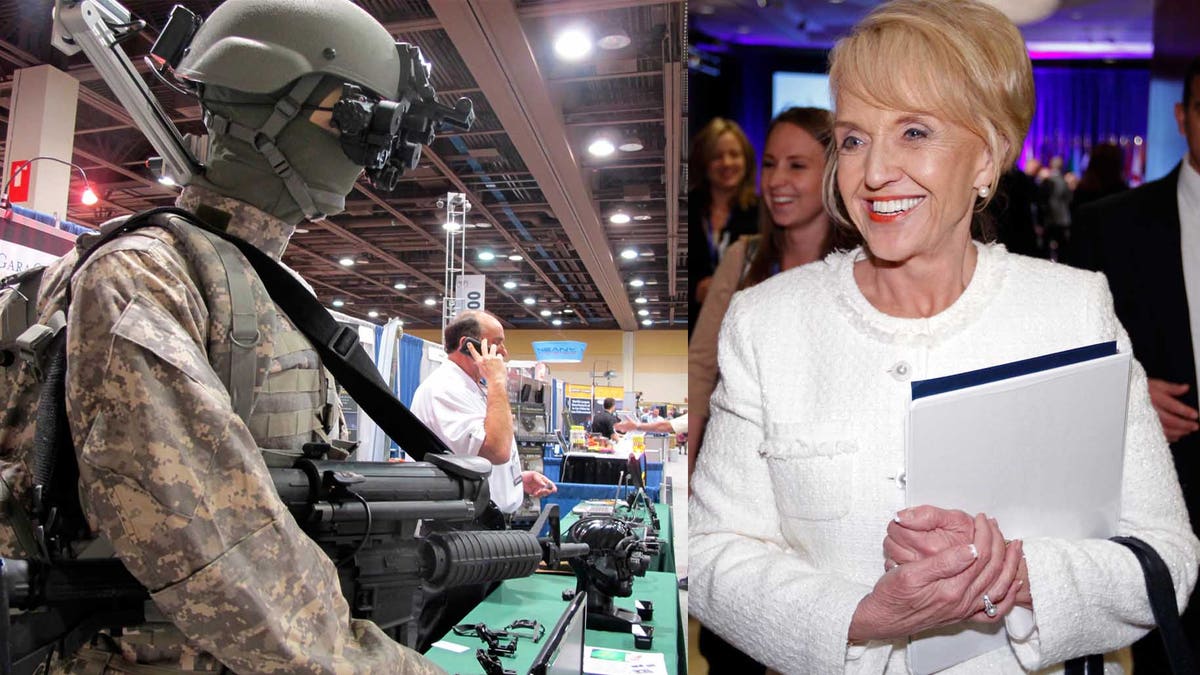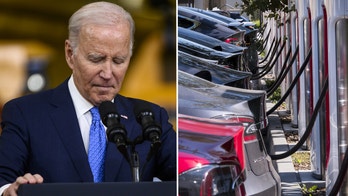
A piece of new technology at the Border Expo pictured left. Arizona Governor Jan Brewer pictured at the right. (FILE PHOTO) (AP)
Arizona Governor Jan Brewer took the time to sound off on the nation's immigration woes while walking by giant new surveillance trucks, unmanned aerial drones, night-vision goggles and giant outdoor camouflaged monitoring centers at a major border security expo in Phoenix.
Speaking to a room of law enforcement officers and those in the border technology industry on Tuesday, Brewer said the immigration issue isn't about hate or skin color, as her critics say — it's about securing the border and keeping Americans safe. Brewer also took the time to invoke the names of a slain rancher and Border Patrol agent.
"Of course, there are those in Washington who will tell you — from 3,000 miles away, by the way — that our border is more secure than ever," Brewer said. "No amount of distortion can hide the absolute truth. The federal government, Republicans and Democrats alike, have failed every single American, all of us."
We've got a lot of rural country, a lot of ranch families and farm families, and a lot of people are living in fear every day. They carry firearms everywhere they go because they simply don't know what they're going to encounter.
Arizona Gov Jan Brewer Endorses GOP Hopeful Mitt Romney ahead of Primary Vote
She said Washington's "abdication of responsibility is the overarching outrage of American illegal immigration crisis."
"America's failure to understand this problem at a national level and to deal with it has haunted borders like mine for decades," she said.
Brewer pointed to the killings of rancher Rob Krentz and Border Patrol Agent Brian Terry.
Authorities believe an undocumented immigrant killed Krentz while he was checking water lines on his property near the Arizona-Mexico border in March 2010.
Terry was killed in a shootout with border bandits in December 2010. A gun used in his shooting was connected to the botched federal operation known as Fast and Furious, in which agents lost track of nearly 1,400 of the more than 2,000 guns purchased by suspected straw buyers.
Later in the day, during a panel discussion by border sheriffs, Chief Deputy Sheriff Rodney Rothrock of southeastern Arizona's Cochise County again brought up Krentz, whose ranch falls under Rothrock's jurisdiction.
Rights Activists Worried About Jan Brewer's Militia Initiative
He said the killing was still being actively investigated and that it is ever-present in many people's minds in the county.
"We've got a lot of rural country, a lot of ranch families and farm families, and a lot of people are living in fear every day," Rothrock said. "They carry firearms everywhere they go because they simply don't know what they're going to encounter."
While Brewer was at the expo, she visited a number of booths where border-security companies displayed their wares in hopes that federal agents would like what they saw and help them win lucrative contracts.
On display were giant trucks equipped for border surveillance that are painted with eagles, all-terrain vehicles with spotlights, unmanned aerial drones, night-vision goggles and giant outdoor camouflaged monitoring centers.
At a booth sponsored by European Aerospace Defense Systems, the governor looked at how the company uses radar and cameras to monitor land. The company will be one of many vying for an upcoming government contract for fixed towers at immigration hot spots along the border, starting in Arizona.
The contract is part of the government's latest strategy to secure the border.
Homeland Security Secretary Janet Napolitano has said the government will use existing, proven technology tailored to the distinct terrain and population density of each region of the nearly 2,000-mile U.S-Mexico border.
She said that would provide faster technology deployment, better coverage and more bang for the buck. She also said the government learned its lesson from a failed high-tech border fence project ordered by Congress in 2006.
The nearly $1 billion program, initiated in 2005 and known as SBInet, was supposed to put a network of cameras, ground sensors and radars along the entire border.
Instead, taxpayers ended up with about 53 miles of operational "virtual fence" in Arizona for a cost of at least $15 million a mile, according to testimony in previous congressional hearings.
Based on reporting by the Associated Press.
Follow us on twitter.com/foxnewslatino
Like us at facebook.com/foxnewslatino




